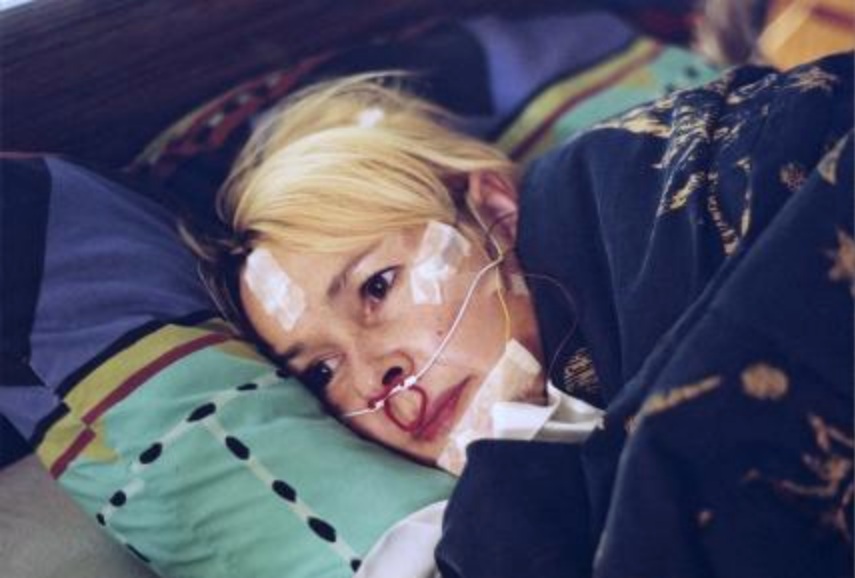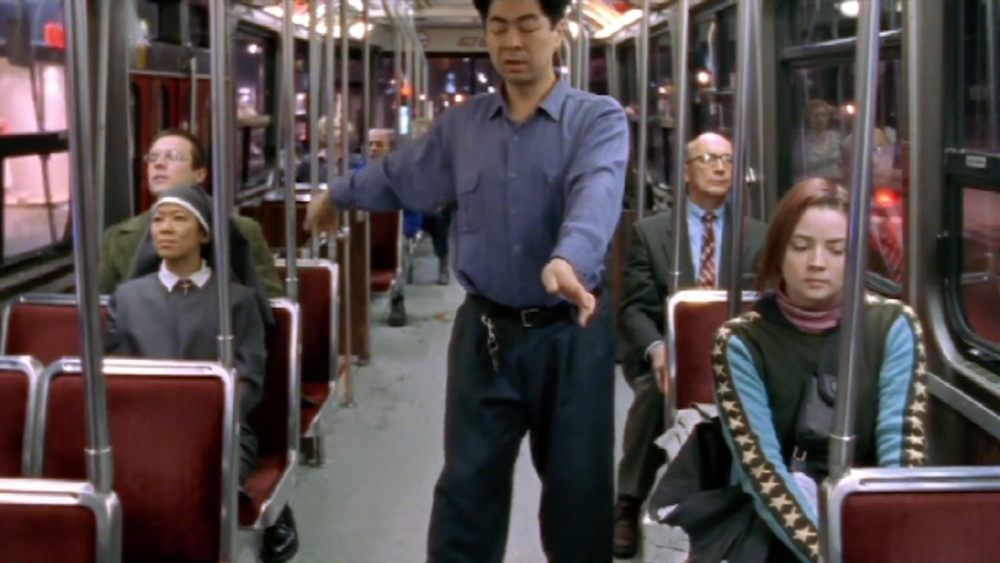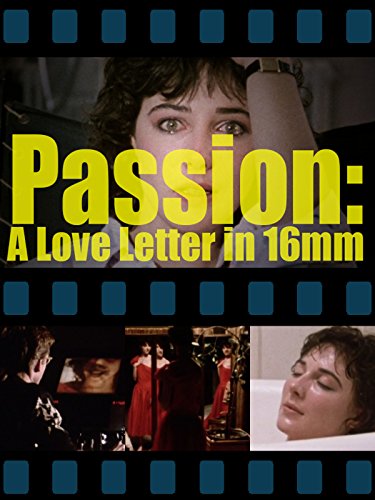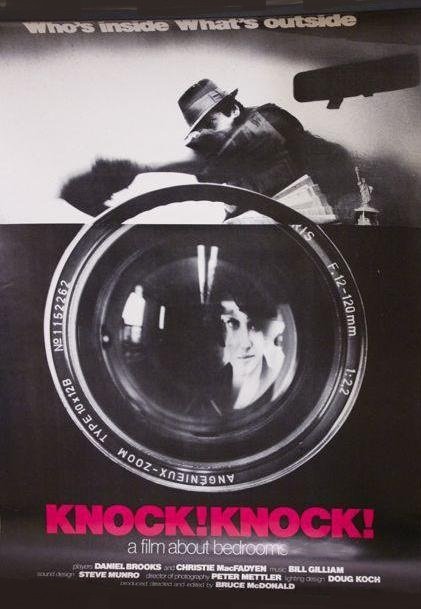Cinematography and Collaborations
Peter Mettler during the filming of Manufactured Landscapes, dir. Jennifer Baichwal (2006)
While his films are immensely personal, an essential component of Mettler’s practice is collaboration and adaptation.
Among his most illustrious collaborators is fellow Torontonian Atom Egoyan, for whom Mettler photographed such films as Next of Kin (1984) and the Samuel Beckett adaptation Krapp’s Last Tape (2000). More recently, Mettler was director of photography on Jennifer Baichwal’s multi-award-winning Manufactured Landscapes (2006), which profiled the work of photographer Edward Burtynsky and opens with one of Mettler’s most indelible shots: a protracted lateral pan that entrances viewers as it gradually coveys the seemingly impossible scale of a factory floor in China. Mettler has also adapted the work of internationally renowned theatre director Robert Lepage with Tectonic Plates (1992), shot on location in Venice, Scotland and Montreal, and which boldly fused the artifice of theatre with wondrous spectacles gleaned from the real world. Most recently, Mettler collaborated with director Emma Davie and philosopher David Abram on the feature Becoming Animal (2018).
Mettler’s additional collaborations also include projects with Bruce McDonald, Jeremy Podeswa, Patricia Rozema, Jane Siberry, Michael Ondaatje, Andreas Zuest, Jim O’Rourke, Fred Frith, Alexandra Rockingham Gill, Ingrid Veninger, Werner Penzel, Peter Weber, Greg Hermanovic, Andrea Nann, Peter Liechti, Gabriel Scotti, Vincent Hanni, Costanza Francavilla, Ritchie Hawtin, Neil Young, and many others.
Broken Land
Switzerland, 2014, 75 minutes.
Directed by Stéphanie Barbey and Luc Peter.
Cinematographer and creative collaboration.
Out in desert-like nature, living in the shadows of the immense fence that is erected to control Mexican immigration, seven Americans tell how the border transforms their lives. They observe the haunting traces left by the crossing migrants – people they never come face to face with – as they confide their fear, defiance and at times even compassion.
National Parks Project: Gros Morne
Canada, 2010, 43 minutes.
Directed by Ryan J. Noth. Produced by FilmCAN and Stitch Media.
Cinematographer.
Immerse yourself in the magnificent glory and intricate wonder of Newfoundland’s Gros Morne National Park as seen through the eyes of master cinematographer Peter Mettler. Mettler’s ever-curious lens finds beauty everywhere, lingering over the cloud and fog that caress the Long Range Mountains, and exploring the textures of granite cliff faces, other-worldly jellyfish, lichen-scarred branches, and rusted iron. The fluid rhythm continually returns to the mesmerizing qualities of water-cascading in waterfalls, lapping shoreline rocks, glinting in trembling droplets, and smearing beauty through window panes.
The Sound of Insects: Record of a Mummy
Switzerland, 2009, 87 minuteS.
Directed by Peter Liechti.
Narration.
Based on the novel Until I Am a Mummy by Shimada Masahiko, The Sound of Insects is the true story of a man who chose an unusual way to end his life: traveling alone to a remote corner of the woods to build a small tent from plastic sheeting and slowly starve to death, allowing nature to gradually rob him of his life. No one knew of his plans until a hunter happened upon his dead body, with insects the only witness to the passing he so desired. Filmmaker Peter Liechti fuses fiction and documentary, using passages from Masahiko's novel as narration while recreating the stranger's journey as he records his thoughts in journals, revels in his loneliness, hallucinates, and anticipates his final hours. Peter Mettler provides narration for the English-language version of the film, while Alexander Tschernek lends his voice to the German edition.
Manufactured Landscapes
Canada, 2006, 90 minutes.
Directed by Jennifer Baichwal, produced by Mercury Films.
Cinematographer and creative collaboration.
Manufactured Landscapes is a feature-length documentary on the world and work of renowned artist Edward Burtynsky. Burtynsky makes large-scale photographs of 'manufactured landscapes' – quarries, recycling yards, factories, mines, dams. He photographs civilization’s materials and debris, but in a way people describe as "stunning" or "beautiful," and so raises all kinds of questions about ethics and aesthetics without trying to easily answer them. The film follows Burtynsky to China as he travels the country photographing the evidence and effects of that country's massive industrial revolution. Sites such as the Three Gorges Dam, which is bigger by 50% than any other dam in the world and displaced over a million people, factory floors over a kilometre long, and the breathtaking scale of Shanghai's urban renewal are subjects for his lens and our motion picture camera.
Shot in Super-16mm film, Manufactured Landscapes extends the narrative streams of Burtynsky's photographs, allowing us to meditate on our profound impact on the planet and witness both the epicentres of industrial endeavour and the dumping grounds of its waste. What makes the photographs so powerful is his refusal in them to be didactic. We are all implicated here, they tell us: there are no easy answers. The film continues this approach of presenting complexity, without trying to reach simplistic judgements or reductive resolutions. In the process, it tries to shift our consciousness about the world and the way we live in it.
Genie Award for Best Documentary, Academy of Canadian Cinema
Best Canadian Film, Toronto International Film Festival
Grand Jury Prize nomination, Sundance Film Festival
Prix du Jeune Publique, Visions du Réel
Top 10 Canadian Movies of the Decade, Macleans
Best Canadian Film and Best Documentary, Toronto Film Critics Association
Into the Night
Canada, 2005, 78 minuteS.
Directed by Annette Mangaard.
Cinematographer.
Set in the lurid, perpetual neon burn of the nighttime city, with its 24-hour stores and restaurants, Into the Night explores sleeplessness and its discontents. Insomnia remains an enigma. More than a third of the world suffers from it, and billions are spent each year on prescription drugs to cure it. Nevertheless, it appears that the real difficulty with this elusive condition is that nobody knows quite what to do about it.
Filmmaker Annette Mangaard, herself a lifelong insomniac, has crafted a searching, lyrical, revelatory film, a sleep-noir journey, tracing one night of her own endless exhaustion – and everybody else's. Mangaard, desperate for some rest, submits herself to a sleep clinic. She talks with wonderfully lucid, hollow-eyed fellow travellers about their varying worlds of sleep deprivation. An unforgettable guide to the nether world of shadows and exhaustion, Into the Night is a cinematic sojourn into the realm of the insomniac – the tracking of a vivid mind moving through the artificial day of night, searching for rest.
Streetcar
Canada, 2004, 30 minutes.
Directed by Nick de Pencier.
Director of Photography.
This award-winning dance film by Nick de Pencier stir imaginations through its hybrid performance-based and experimental documentary approach. For his performance, Peter Chin received a prestigious Gemini Award, and was also responsible for the choreography and music composition. de Pencier was also nominated for a Gemini for Best Director.
Krapp’s Last Tape
Ireland, 2000, 58 minutes.
Directed by Atom Egoyan.
Cinematography.
Samuel Beckett’s one-act play Krapp’s Last Tape (1958) depicts an old man who sits alone at a table and listens to tape recordings of his voice over the span of his life. Atom Egoyan’s adaptation of the play, commissioned as part of the “Beckett On Film” series, is a minimalist production acutely aligned with the text version, featuring a masterful performance from actor John Hurt. In 2011, Atom Egoyan adapted Krapp’s Last Tape into a multimedia installation, Steenbeckett.
The Ring
UK/Slovenia, 2004, 90 minutes.
Directed by Angus Reid.
Director of Photography.
European artists frame the openness of the world in works of art. In gold mines in Africa, slaves dig for precious metal, and the story of the camps in Bosnia can only be told by those who survived them. This documentary epic brings the value of art into direct confrontation with its own extinction. It searches for a lost ring, a sense of connection, mapping at the same time the brokenness of the 90s, the circle closing fifteen years after the first scene was filmed, 1989–2004. This circle is an odyssey that encounters its nemesis in a picaresque philosopher who contemplates nothingness, and an essay that must step past the graves in Burkina Faso and Bosnia – the circle of the life work of the author who has discovered his intimate Ithaca somewhere between Slovenia and Scotland, a hideaway from the nihilism of the ring, embodying death, gold and apathy, the symbols of the world that survives us.
Best Central European Documentary Film, Jihlava International Documentary Film Festival.
leda & the swan
Canada, 1998, 100 minutes.
Directed by Alexandra Rockingham Gill.
Cinematography.
The first feature from Alexandra Rockingham GIll, leda & the swan is an intimate, sensual rendering of the impulses that shape our search for meaning. A filmmaker asks two actors to dramatize a personal story about a traumatic love affair, and quickly finds herself deeply immersed not only in the actors' complex interpretation of her story, but also in the emotional world of their own evolving relationship. Through the intermingling of the ancient myth of Leda and the Swan, the filmmaker's personal story, and the intricate dynamics of the young actors, the deeper, poetic and archetypal aspects of all love stories – of all stories – begin to converge. Starring Gariné Torosian and Jacob Wren.
The Life is the Red Wagon
Canada, 1989, 4 minutes.
Cinematography.
Music video for iconic Canadian folk songstress Jane Siberry.
Family Viewing
Canada, 1987, 86 minutes.
Directed by Atom Egoyan.
Cinematography.
Van's father, Stan, is fond of video, always taping scenes of daily family life. But he does not take care of Van's grandmother, Armen. Although he could afford having her at home, she is spending her days watching TV in an old people's home. Van often visits her. He meets Aline, whose mother is in the next bed. Van wants to get his grandma out of the old people's home. Aline will help. Actually, Van, whose mother left, years ago, is looking for a real family life.
Walking After Midnight
Canada, 1988, 92 minutes
Directed by Jonothan Kay.
Cinematography.
A documentary that explores the past-life experiences of various celebrities.
Artist on Fire: The Work of Joyce Wieland
Canada, 1987, 54 minutes.
Directed by Kay Armatage.
Cinematography.
Joyce Wieland was one of Canada's most exciting and innovative artists. She worked in virtually every medium, including cloth, pastels, coloured pencils, oils, bronze, watercolours, and film. One of the founding group of what came to be known as structural film, she was also one of the first contemporary artists to incorporate women's traditional crafts, using both film and cloth as platforms for her principal subjects of ecology, nationalism, and feminism. Artist on Fire combines expressionistic uses of cinematography and sound to examine Wieland's work in all media. Armatage interweaves multiple unscripted voices in an evocative soundtrack of effects and music with an illuminating juxtaposition of images: excerpts from Wieland's work over twenty years, artworks in many modes, and footage of Wieland at work.
"An astoundingly dynamic piece of filmmaking – an intense marriage between Armatage and Wieland's art." – The Globe and Mail
Divine Solitude
Canada, 1986, 28 minutes.
Directed by Jean-Marc Lariviere.
Cinematography.
A performance film featuring dancer-choreographer Nana Gleason, whose solo works are an incisive and spellbinding alchemy of modern Western dance forms and Far-Eastern traditions.
“Lariviere, supported by the discreet cinematography of Peter Mettler and Kemp Archibald, has kept his distance, eschewed bravado and made a beautiful work of art.” – TIFF
Passion: A Letter in 16mm
Canada, 1985, 28 minutes.
Directed by Patricia Rozema.
Cinematography.
The first film by the award-winning director of I've Heard the Mermaids Singing. The story of a woman with too much passion and too little time. Linda Griffiths portrays a woman struggling to balance her craving for professional excellence as a documentary filmmaker with her need for intimacy.
Knock! Knock!
Canada, 1985, 62 minutes.
Directed by Bruce McDonald.
Cinematography.
The first feature by award-winning director Bruce McDonald (Roadkill, Hard Core Logo, Pontypool). Starring Daniel Brooks, Kevan Buss, Christie MacFadyen, and Atom Egoyan.
Next of Kin
Canada, 1984, 100 minutes.
Directed by Atom Egoyan.
Cinematography.
Twenty-three-year old Peter Foster is an only child who lives at home, where he constantly hears his parents arguing. Because Peter does nothing all day, the family goes to a clinic where a therapist videotapes them. After Peter watches his tape, he views the tape of a troubled Armenian family, who gave their only son away for adoption when they arrived in Canada. Peter decides to visit this family, and he pretends to be their son, Bedros Deryan. The Deryan family welcomes him with open arms, and Peter tries to patch up the poor relationship between George Deryan and his daughter Azah.
A Trip Around Lake Ontario
Canada, 1984, 26 minutes.
Directed by Colin Brunton.
Cinematography.
An author takes a trip around Lake Ontario to research a book and offers a "fact or fiction" comic narration on the people he meets. Shot prior to writing the novel of the same name, A Trip Around Lake Ontario becomes a film based on a book based on a film. With David McFadden and Al Purdy.
David Roche Talks To You About Love
Canada, 1983, 22 minUteS.
Directed by Jeremy Podeswa.
Cinematography.
David Roche looks out from the screen and starts to talk about love as he rises in the freight elevator to his lofty abode. From the first few sentences, it's clear that here's a literate, witty script executed by an actor/writer who, in conjunction with the filmmaker, knows how to convey his autobiographical, deja-vu views. Poignant. Beautiful. Cynical. It is an insight into human relationships for those of all persuasions.
Open House
Canada, 1982, 25 minutes.
Directed by Atom Egoyan.
Cinematography.
One of the first short films by award-winning director Atom Egoyan. An odd young real estate agent shows a couple an older house that has seen better days.





















